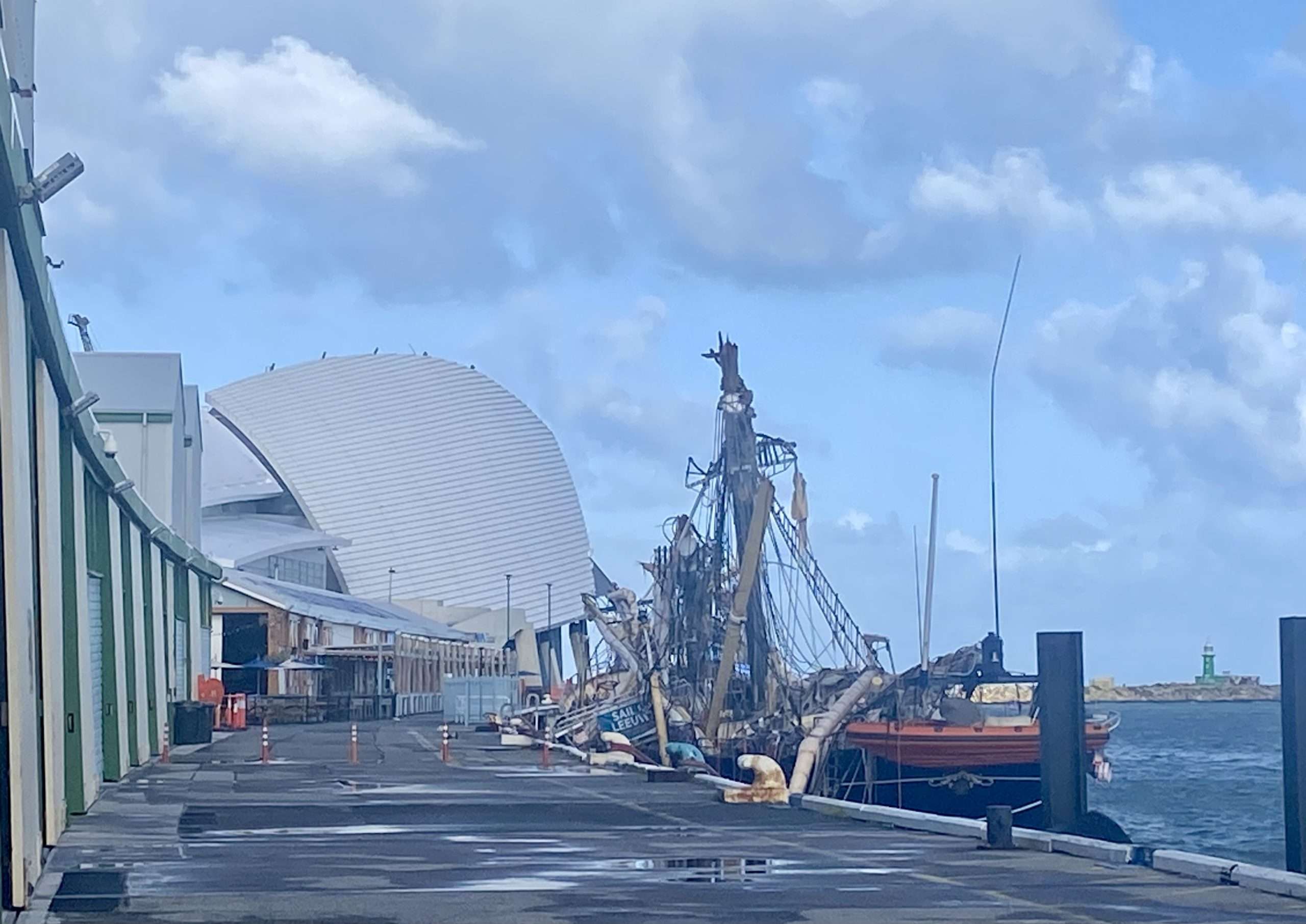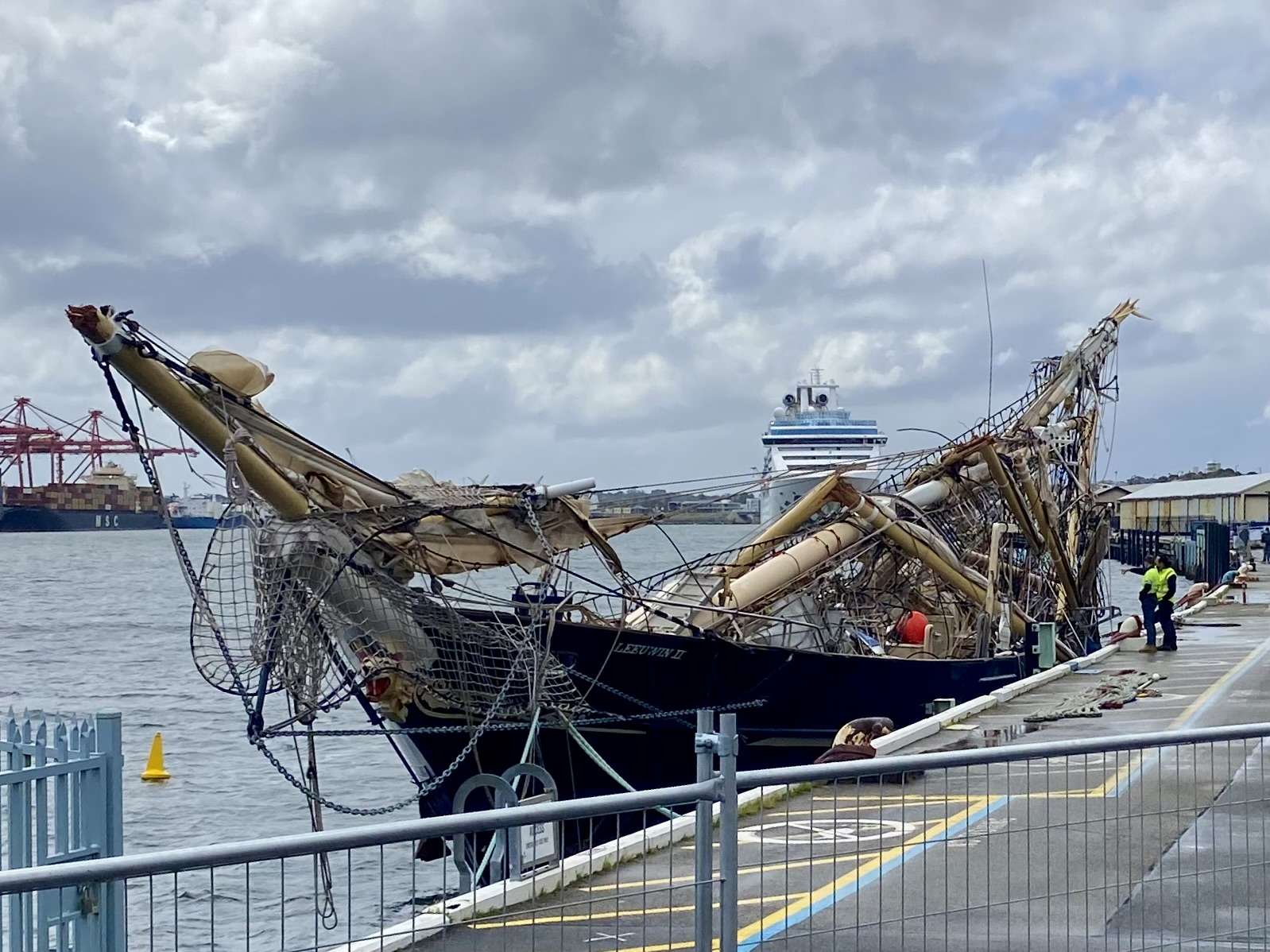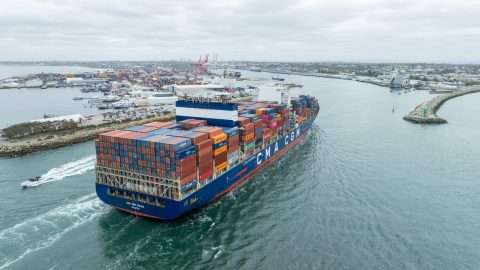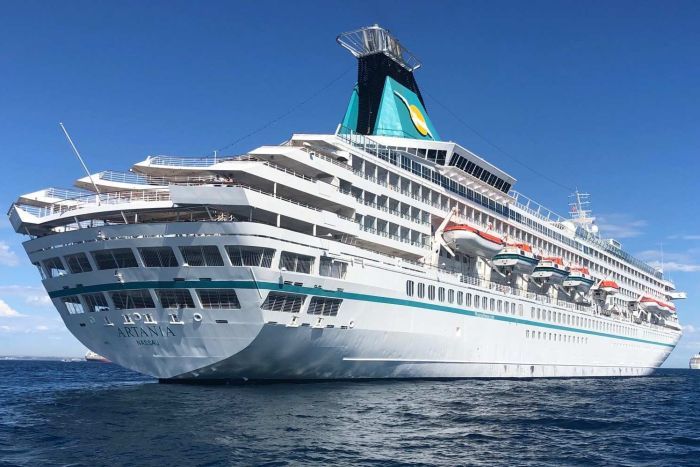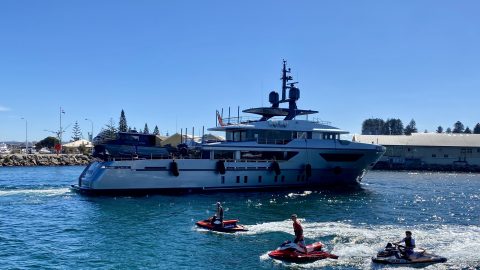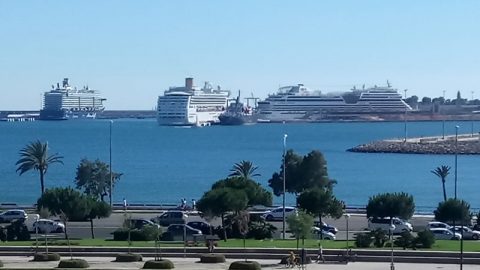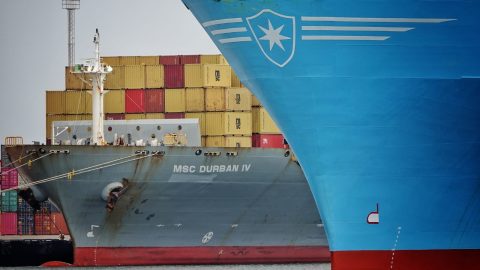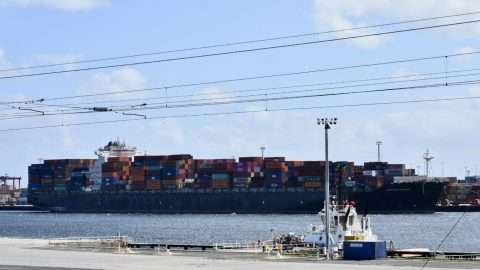The interim report outlines what happened but contains no analysis or findings; these will be released in the ATRB’s final report that’s due in the third quarter of 2025.
The report contains exact times and actions of all involved and can be read in full here.
What we now have, that is new, is CCTV footage of the moment of impact on a dark, wet and windy morning on 30 August 2024.
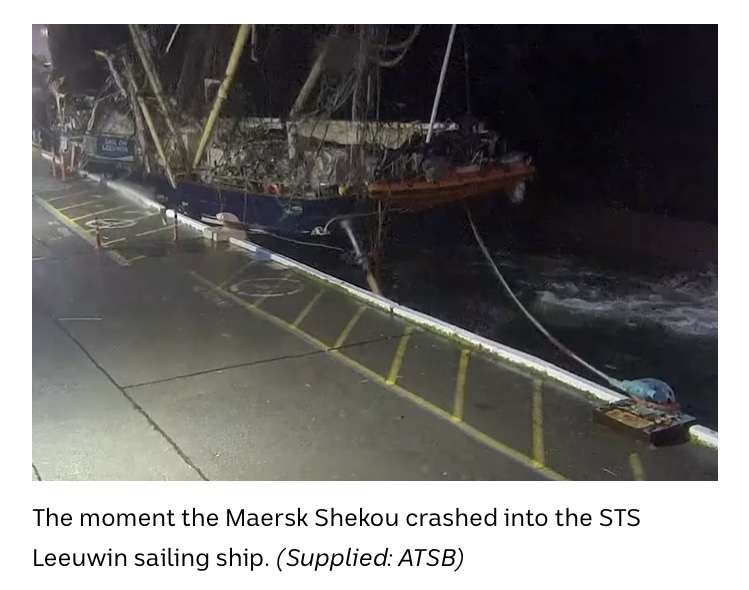
The interim report provides many new details of the accident.
The report highlights that despite the combined efforts from two pilots, four tugs and experienced ship’s master and crew, the container ship lost steerage, struck and demasted the stationary Leeuwin and then damaged the WA Maritime Museum and Victoria Quay.
The report describes how the crew of the container ship, pilots and tug crew fought hard to keep the ship on course amid stronger than forecasted wind gusts.
The Maersk Shekou arrived off the Port of Fremantle, following a voyage from Adelaide, South Australia and commenced drifting off the coast while awaiting entry into the port.
The ship was loaded with 4,164 containers. Due to industrial action taking place in the port, the ship’s scheduled 22 August berthing time had been postponed to 25 August.
Thereafter, Fremantle Port was evacuated of all vessel traffic due to unfavourable weather conditions, and Maersk Shekou’s pilot boarding time was rescheduled to 0700 on 30 August.
At 0500, the pilot made VHF radio contact with Fremantle vessel traffic service advising that Maersk Shekou had just passed the Fairway Landfall buoy. During this time, the second (secondary) pilot set up their portable pilot unit aerials on the bridge wing.
The container ship continued its inbound transit with the bridge team comprising the 2 pilots, master, third mate, and an ordinary seafarer at the helm. The chief mate relieved the third-mate at about 0525, and an able seafarer also relieved the helmsman a few minutes later. The pilots engaged in various work-related and social discussions during the transit. The vessel’s bridge team was also engaged in separate conversations in a non-English language.
During the inbound transit, the Maersk Shekou experienced strong winds. By 0518, while on a southerly heading, the relative wind gusts peaked at 54 knots from about 4 points on the starboard bow.
The report states:
At around 0612:36, the vessel developed a slight starboard rate of turn. To maintain the 085° heading ordered by the pilot, the helmsman put the helm over to port 25° and then port 30°. The wind speed was steadily increasing and by 0612:50, the vessel was encountering a persistent relative wind speed of 40 knots on the starboard quarter. Despite the port 30° helm, the vessel continued to swing slowly to starboard [towards the Leeuwin] and was heading approximately 086°. The pilot ordered the helmsman to steer 083° and the Svitzer Falcon tug was made fast at the Maersk Shekou’s starboard shoulder. Despite the helm being maintained nearly at hard port, the vessel was heading almost 087°, making good 7.5 knots, with a 1°/min rate of turn to starboard.
The primary pilot was conning the vessel from the front of the wheelhouse, the secondary pilot was stationed at the rear. At 0614:40, the pilot ordered Svitzer Eagle to ‘come out square, on the starboard quarter. With the helmsman continuing to maintain the helm nearly at hard port, the Maersk Shekou’s bow started slowing swinging to port. At 0615:10, the master advised the pilot that the relative wind speed had increased to 45 knots, which the pilot acknowledged.
By 0615:16, the vessel was making good 7.1 knots and continued to swing to port, achieving a maximum rate of turn of 9°/min. However, as the heading came around to 086°, the helmsman brought the helm to midship and then to starboard 33° for a brief period before returning it to midship. The helmsman’s actions resulted in the vessel’s port swing being arrested, and the vessel being steadied on a heading of approximately 083°, into the path of A and B berths at Victoria Quay. With neither pilot nor the ship’s bridge team observing the actions of the helmsman, the primary pilot informed the secondary pilot that they were in trouble…
The ship was proceeding at 7.2 knots on a steady path towards STS Leeuwin II, which was less than a ship’s length away, and moored port side alongside B berth at Victoria Quay.
Despite altering course, deploying port bow thrusters at full power, and the efforts of the tugs, the container ship kept swinging to port. Then the full astern order was given, reducing the speed to 5.7 knots. The port anchor was released and the ship’s whistle sounded to caution an impending collision. In driving rain and winds up to 45knots, the Svitzer Falcon had to abandon their position to prevent being crushed between Victoria Quay and the hull of Maersk Shekou. They had prepared for an emergency evacuation.
Maersk Shekou’s starboard bow collided with the STS Leeuwin II, dismasting her. Two Leeuwin crew members escaped via its gangway just as the collision occurred. Maersk Shekou had lost almost all speed. However, its bow was still swinging to port and its stern moving to starboard in the direction of the WA Maritime Museum. The outermost stack of containers on the Maersk Shekou’s poop deck collided with the roof of the museum, as you can see in this image provided with the report, and the vessel’s starboard quarter contacted the wharf.
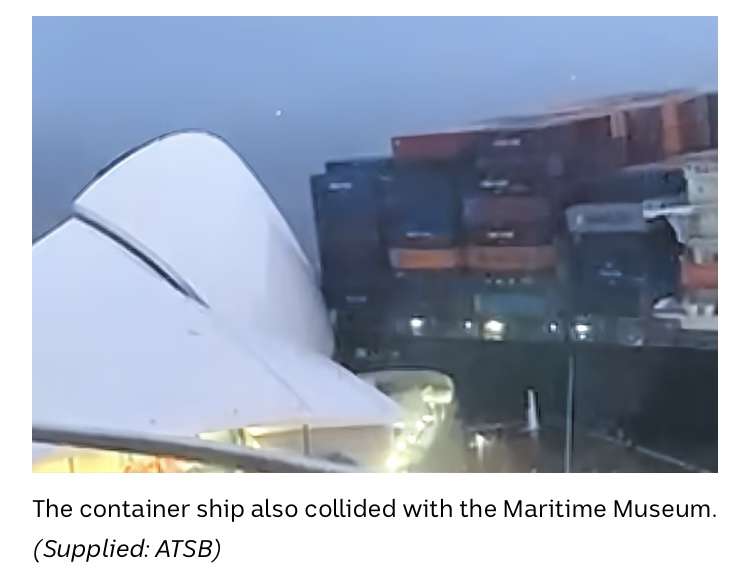
Two relief pilots boarded the Maersk Shekou at 0713 and she was then navigated into the inner harbour and safely made fast to its berth by 0930.
The Maersk Shekou sustained minor damage. However, as we know, STS Leeuwin II sustained substantial damage and 2 of its crew-members sustained minor injuries during the incident.
Maersk Shekou had a crew of 26 Ukrainian, Lithuanian, Burmese and Romanian nationals. The master had 35 years’ experience at sea and held a Ukrainian master mariner’s certificate of competency.
The ATSB report indicates that to date the investigators have –
• interviewed the vessel’s master and crew, both pilots, tug skippers and VTSOs
• reviewed:
~ recordings of relevant communications and written communications between various parties
~ bridge recordings
~ Fremantle Pilots and Fremantle Ports procedures
~ Bureau of Meteorology data
~ the vessel’s logs and records.
The investigation is continuing and will include further review and examination of:
• pilots and crew actions including bridge resource management
• shipboard SMS, port and pilotage procedures for inbound vessels.
A final report will be released at the conclusion of the investigation. Should a critical safety issue be identified during the course of the investigation, the ATSB says it will immediately notify relevant parties so appropriate and timely safety action can be taken.
The result of the accident has been devastating for the much loved Leeuwin Sail Training Ship with loss of sailing and revenue for the season.
In that regard, Leeuwin Ocean Adventure Foundation, CEO, Lawson Dixon, says the Foundation is grateful to the ATSB for their thorough investigation and to understand the sequence of events that led up to the accident.
However, he added: “We have lost at least 12 months of voyaging and approximately $3 million in income . . . sadly we have had to farewell some of our crew. We are now looking forward to being able to focus on rebuilding our famous tallship and getting back to serving the people of Western Australia.”
We look forward to seeing a tall training ship about Freo again before too long.
* Words and photographs (except where indicated otherwise) by Jean Hudson our Shipping Correspondent. Jean is also a regular feature writer and photographer here on the Shipping News. You may also like to follow up her informative Places I Love stories, as well as other feature stories and Freo Today photographs, right here.
~ If you’d like to COMMENT on this or any of our stories, don’t hesitate to email our Editor.
~ WHILE YOU’RE HERE –
PLEASE HELP US TO GROW FREMANTLE SHIPPING NEWS
FSN is a reader-supported, volunteer-assisted online magazine all about Fremantle. Thanks for helping to keep FSN keeping on!
~ Don’t forget to SUBSCRIBE to receive your free copy of The Weekly Edition of the Shipping News
